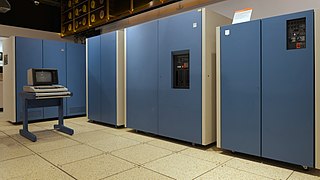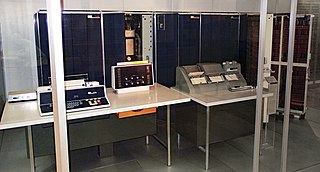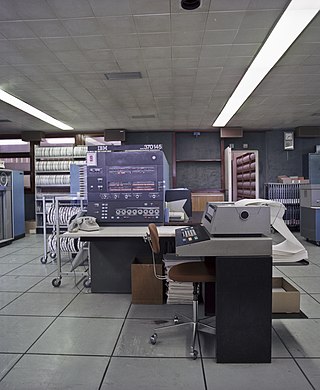A control store is the part of a CPU's control unit that stores the CPU's microprogram. It is usually accessed by a microsequencer. A control store implementation whose contents are unalterable is known as a Read Only Memory (ROM) or Read Only Storage (ROS); one whose contents are alterable is known as a Writable Control Store (WCS).
IBM mainframes are large computer systems produced by IBM since 1952. During the 1960s and 1970s, IBM dominated the computer market with the 7000 series and the later System/360, followed by the System/370. Current mainframe computers in IBM's line of business computers are developments of the basic design of the System/360.

The IBM System/360 (S/360) is a family of mainframe computer systems that was announced by IBM on April 7, 1964, and delivered between 1965 and 1978. It was the first family of computers designed to cover both commercial and scientific applications and a complete range of applications from small to large. The design distinguished between architecture and implementation, allowing IBM to release a suite of compatible designs at different prices. All but the only partially compatible Model 44 and the most expensive systems use microcode to implement the instruction set, featuring 8-bit byte addressing and fixed point binary, fixed point decimal and hexadecimal floating-point calculations.

The IBM System/370 (S/370) is a range of IBM mainframe computers announced as the successors to the System/360 family on June 30, 1970. The series mostly maintains backward compatibility with the S/360, allowing an easy migration path for customers; this, plus improved performance, were the dominant themes of the product announcement.

The IBM 700/7000 series is a series of large-scale (mainframe) computer systems that were made by IBM through the 1950s and early 1960s. The series includes several different, incompatible processor architectures. The 700s use vacuum-tube logic and were made obsolete by the introduction of the transistorized 7000s. The 7000s, in turn, were eventually replaced with System/360, which was announced in 1964. However the 360/65, the first 360 powerful enough to replace 7000s, did not become available until November 1965. Early problems with OS/360 and the high cost of converting software kept many 7000s in service for years afterward.

The IBM 4300 series are mid-range systems compatible with System/370 that were sold from 1979 through 1992. They featured modest electrical and cooling requirements, and thus did not require a data center environment. They had a disruptive effect on the market, allowing customers to provide internal IBM computing services at a cost point lower than commercial time-sharing services. All 4300 processors used a 3278-2A, 3279-C or 3205 display console rather than a 3210 or 3215 keyboard/printer console.
Memory segmentation is an operating system memory management technique of dividing a computer's primary memory into segments or sections. In a computer system using segmentation, a reference to a memory location includes a value that identifies a segment and an offset within that segment. Segments or sections are also used in object files of compiled programs when they are linked together into a program image and when the image is loaded into memory.
The Job Entry Subsystem (JES) is a component of IBM's MVS mainframe operating systems that is responsible for managing batch workloads. In modern times, there are two distinct implementations of the Job Entry System called JES2 and JES3. They are designed to provide efficient execution of batch jobs.

IBM 7070 is a decimal-architecture intermediate data-processing system that was introduced by IBM in 1958. It was part of the IBM 700/7000 series, and was based on discrete transistors rather than the vacuum tubes of the 1950s. It was the company's first transistorized stored-program computer.
The history of IBM mainframe operating systems is significant within the history of mainframe operating systems, because of IBM's long-standing position as the world's largest hardware supplier of mainframe computers. IBM mainframes run operating systems supplied by IBM and by third parties.

OS/360, officially known as IBM System/360 Operating System, is a discontinued batch processing operating system developed by IBM for their then-new System/360 mainframe computer, announced in 1964; it was influenced by the earlier IBSYS/IBJOB and Input/Output Control System (IOCS) packages for the IBM 7090/7094 and even more so by the PR155 Operating System for the IBM 1410/7010 processors. It was one of the earliest operating systems to require the computer hardware to include at least one direct access storage device.
The IBM 2361 Large Capacity Storage (LCS) is an optional component of the IBM System/360 models 50, 65 (when not being used as a multiprocessor), and 75 computers. Storage is implemented using magnetic cores; the cycle time is 8 microseconds and the access time is 3.6 microseconds. This component is also called IBM 2361 Core Storage or IBM 2361 Large Core Storage. It provides additional main storage with a slower access time than the standard storage of the machine—for example 8 microseconds compared to 750 nanoseconds for main storage on the Model 65.

The IBM System/360 Model 50 is a member of the IBM System/360 family of computers. The Model 50 was announced in April 1964 with the other initial models of the family, and first shipped in August 1965 to the Bank of America.

The IBM System/360 Model 65 is a member of the IBM System/360 family of computers. It was announced April 1965, and replaced two models, the Model 60 and Model 62, announced one year prior but never shipped. It was discontinued in March 1974.

The IBM System/360 Model 85 is a high-end member of the System/360 family of computers, with many advanced features, and was announced in January 1968 and first shipped in December 1969. IBM built only about 30 360/85 systems because of "a recession in progress".

The IBM System/370 Model 155 were jointly announced Jun 30, 1970 as "designed for ... the Seventies." That same day IBM announced the 370/195. They were the first three models of the IBM System/370 line of computers.

The IBM System/370 Model 145 was announced September 23, 1970, three months after the 155 and 165 models. It was the fourth member of the IBM System/370 line of computers, and was the first IBM computer to use semiconductor memory for its main memory instead of magnetic core memory. It was described as being five times faster than the IBM System/360 Model 40. First shipments were scheduled for late summer of 1971.

The IBM System/370 Model 135 was announced March 8, 1971, the only 370 introduced that year. The 135 was IBM's fifth System 370, and it was withdrawn October 16, 1979.

The IBM System/370 Model 168 and Model 158 were both announced on August 2, 1972. Prior 370 systems had not "offered virtual storage capability, which was to be a hallmark of the 370 line," and some said that the 168 and 158 were the first "real 370" products. By contrast, "in 1972, the System/370 Advanced Function was released and had new Address Relocation Hardware and now supported four new operating systems ."













